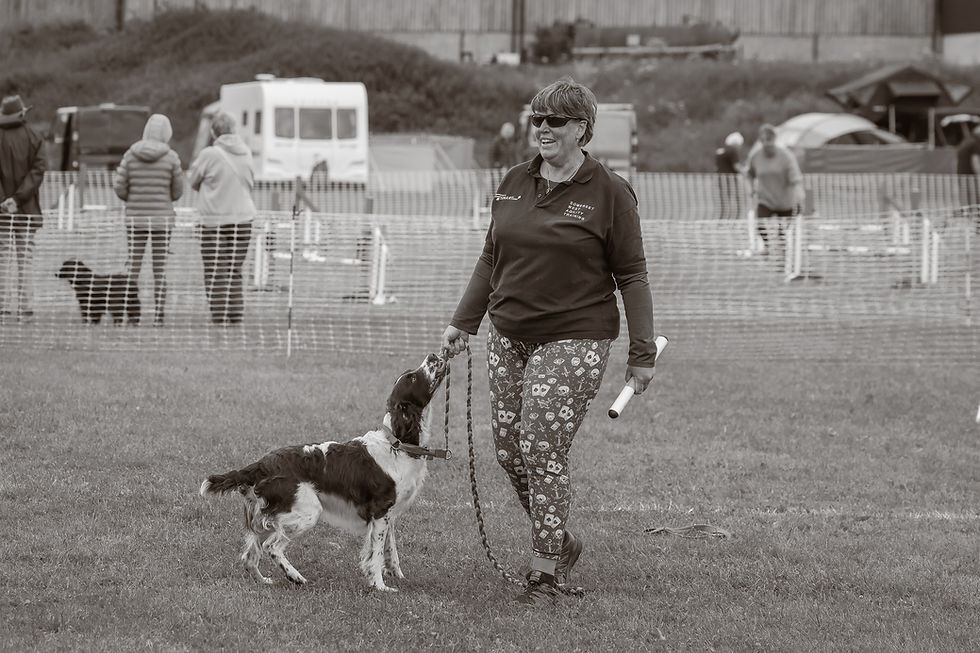Stop Right There! Teaching The Concepts of Stillness and Duration
- Sara Seymour

- Jan 11, 2023
- 4 min read
Updated: Jan 3
A question that has come up a few times recently in one of the canine fitness groups I'm in is how to build duration in conditioning exercises with a dog that can't stay still for a nanosecond. The response that I frequently give is that we need to teach the concept of stillness, and 'do nothing' away from the conditioning work. I also said I should probably do a video to explain what I mean - so here it is, along with a blog post to explain more!
A lot of us have experienced a dog that starts throwing behaviours at us the moment they think that food may be on offer; they start working through their repertoire of tricks - sit, down, stand, spin left, spin right, beg, bark and so on! In part this comes about because when we do shaping sessions we WANT our dogs to offer behaviours - we need them to do something that we can click for. However, a few years ago now it became clear to me that there was another (better?) way... In the absence of other information, I prefer my dogs to do nothing. To keep still, and perhaps offer eye contact. I first learned this concept from Sarah Owings in her ClickerExpo talk 'Control is an Illusion' - I highly recommend checking it out!
So - what does this look like? Recently, Peak has been learning a 'Stand By' behaviour - to stand in front of me offering eye contact. I have food in both my hands here. I'm alternating between two different marker cues; 'food' means I will place the treat on the floor between his feet, and 'yes' is a general marker cue so he takes the food from my hand. I should have actually used 'take' which specifically means to take the food from my hand, but hey, we all make mistakes 😂 I generally use 'floor' when he sits to get him standing again. He's getting better at staying standing, but I still need to build more value for that. Those paying close attention will see that this is basically the Control Unleashed 'Up Down' Pattern Game.
Next up is a video showing another way I can help my dog be still during training - I use a platform in order to create a clean loop. The rep starts and ends on the platform. As he already has a lot of value for the platform, he's going to stay on there until cued otherwise. This helps to build a smooth session with little to no frustration. When he isn't sure of something he either stays on the platform, or returns to it. Platforms pay well!
Next up we have a clip of Peak working on standing on two balance bars. He's still very much learning where all his legs are and what they do, so it's a bit messy! You can also see quite how busy he is - stillness isn't easy! His little brain was also a bit fried by that point... For him, I do use an occasional 'wait' cue, as he understands that means to hold still. He has a LOT of value for sitting - he came with that at ten weeks. You may also spot that I use a bit of reverse luring - that is, I keep my hand open when he's doing the thing I want. This can help to keep his head forward and in a good position. I have to move my stool - I find with him that being in front doesn't work. There's a chance that this is because he has a preference for being next to me.
Here's the final clip - Peak LOVES the two toy game. I prefer not to do repetitive long throws to toys on the ground, so we've developed a game where he goes around me and I toss the toy a short distance for him to catch in the air. He's still busy processing the rest of the training, and these are his favourite toys, so it's not the smoothest game. However, on the second rep see how I pause before cueing the 'around' - that's stillness and duration right there, which gets reinforced with one of his favourite things! On the next rep, I do a little cue discrimination - I pause, then cue 'lie'. This is the first time I've done that, so it's no real surprise when he goes around me - that's what he was expecting to do! Next time, he listens and succeeds.
Hopefully these clips have helped you to see that there are many different ways that we can introduce the concept of stillness and duration to our dogs, and that we can (and should) incorporate this into our regular training sessions. I'll pop the full, unedited, session at the end of this post - you should be able to spot even more instances of stillness and duration in there!
Finally, I know that people will ask what I do when I WANT my dogs to offer behaviours (i.e. a shaping session) - in those cases I will try to make sure that the context is different. I'll most likely be sat down. If I'm using a prop, I'll make sure that my dog notices me placing it as they are likely to go and investigate - there's my first click. I'll also aim to click early so that they know that the game is ON. In contrast, if I'm working on cued behaviours then I'll get a cue in quickly so that they know that's what we're going to be doing.
Happy training,



